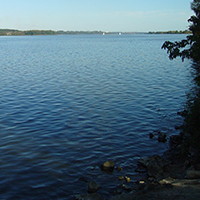Microcosm on a bottle: experimental tests on the colonization of plastic and glass substrates in a retention reservoir
Micro- and macroorganisms in a eutrophic reservoir

Submitted: 30 December 2019
Accepted: 16 March 2020
Published: 27 March 2020
Accepted: 16 March 2020
Abstract Views: 1658
PDF: 429
HTML: 28
HTML: 28
Publisher's note
All claims expressed in this article are solely those of the authors and do not necessarily represent those of their affiliated organizations, or those of the publisher, the editors and the reviewers. Any product that may be evaluated in this article or claim that may be made by its manufacturer is not guaranteed or endorsed by the publisher.
All claims expressed in this article are solely those of the authors and do not necessarily represent those of their affiliated organizations, or those of the publisher, the editors and the reviewers. Any product that may be evaluated in this article or claim that may be made by its manufacturer is not guaranteed or endorsed by the publisher.
Similar Articles
- Tomasz Mieczan, Małgorzata Adamczuk, Monika Tarkowska-Kukuryk, Dorota Nawrot, Effect of water chemistry on zooplanktonic and microbial communities across freshwater ecotones in different macrophyte-dominated shallow lakes , Journal of Limnology: Vol. 75 No. 2 (2016)
- Mircea Alexe, Gheorghe Șerban, Andreea Baricz, Adrian-Ștefan Andrei, Adorján Cristea, Karina P. Battes, Mirela Cîmpean, Laura Momeu, Vasile Muntean, Sebastian A. Porav, Horia L. Banciu, Limnology and plankton diversity of salt lakes from Transylvanian Basin (Romania): A review , Journal of Limnology: Vol. 77 No. 1 (2018)
- Zacarias Fresno Lopez, Tommaso Cancellario, Diego Fontaneto, Lyudmila Kamburska, Karimullah Karimullah, Robert L. Wallace, Elizabeth J. Walsh, Radoslav Smolak, A georeferenced dataset for occurrence records of the phylum Rotifera in Africa , Journal of Limnology: Vol. 82 No. s1 (2023): Georeferenced freshwater biodiversity data
- Tomasz Mieczan, Urszula Bronowicka-Mielniczuk, Ciliates in different types of pools in temperate, tropical, and polar climate zones – implications for climate change , Journal of Limnology: Vol. 81 (2022)
- Joanna Martinet, Stéphane Descloux, Pierre Guédant, Frederic Rimet, Phytoplankton functional groups for ecological assessment in young sub-tropical reservoirs: case study of the Nam-Theun 2 Reservoir, Laos, South-East Asia , Journal of Limnology: Vol. 73 No. 3 (2014)
- Monika Tarkowska-Kukuryk, Tomasz Mieczan, Effect of substrate on periphyton communities and relationships among food web components in shallow hypertrophic lake , Journal of Limnology: Vol. 71 No. 2 (2012)
- Jordi Catalan, John C. Donato Rondón, Perspectives for an integrated understanding of tropical and temperate high-mountain lakes , Journal of Limnology: Vol. 75 No. s1 (2016): Proceedings of the 6th National Congress of Limnology
You may also start an advanced similarity search for this article.

 https://doi.org/10.4081/jlimnol.2020.1958
https://doi.org/10.4081/jlimnol.2020.1958





